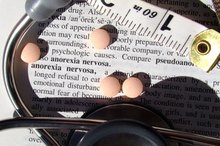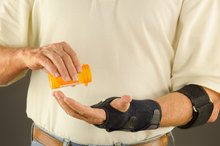What does fact checked mean?
At Healthfully, we strive to deliver objective content that is accurate and up-to-date. Our team periodically reviews articles in order to ensure content quality. The sources cited below consist of evidence from peer-reviewed journals, prominent medical organizations, academic associations, and government data.
The information contained on this site is for informational purposes only, and should not be used as a substitute for the advice of a professional health care provider. Please check with the appropriate physician regarding health questions and concerns. Although we strive to deliver accurate and up-to-date information, no guarantee to that effect is made.
Pelvic prolapse occurs when the muscles and ligaments supporting a woman’s pelvis weaken and pelvic organs such as the bladder and uterus slip out of place. Childbirth, menopause and hysterectomy are some of the common risk factors for pelvic organ prolapse. Treatment options depend upon the organs involved and surgery may be recommended to treat severe cases. Along with Kegel exercises, certain vitamin and mineral supplements may help prevent pelvic prolapse.
Vitamin D
Vitamin D is a fat-soluble vitamin found in fish, oysters and dairy products. Significant amounts of vitamin D can also be produced by the human body when exposed to sunlight for at least 10 minutes during the day. Individuals with minimal sun exposure and strict vegans and vegetarians may consider taking synthetic vitamin D supplements that can be purchased at most pharmacies without a prescription. However, it is important to follow dosage instructions on the label of the supplements as chronic overuse of the supplements can lead to kidney stones, vomiting and muscle pain. Vitamin D plays an important role in promoting bone health by helping the body absorb calcium and phosphorus more efficiently. A study published in the April 2010 edition of the “Obstetrics and Gynecology” states that one in four women in the United States have some form of pelvic floor disorder, and higher levels of vitamin D may reduce the risk of conditions such as pelvic organ prolapse and urinary incontinence 1.
- Vitamin D is a fat-soluble vitamin found in fish, oysters and dairy products.
- Individuals with minimal sun exposure and strict vegans and vegetarians may consider taking synthetic vitamin D supplements that can be purchased at most pharmacies without a prescription.
Vitamin C
Vitamins for an Overactive Bladder
Learn More
Vitamin C, or ascorbic acid, is a water-soluble vitamin that is essential for growth, development, repair and maintenance of several tissues and organs of the body. It also plays a crucial role in the synthesis of collagen which is an essential component of the ligaments that hold the pelvic floor and pelvic organs. Citrus fruits, berries, tomatoes, peppers and green leafy vegetables are good sources of vitamin C, along with synthetic supplements. Upset stomach and diarrhea are the most common side effects associated with vitamin C overdose.
- Vitamin C, or ascorbic acid, is a water-soluble vitamin that is essential for growth, development, repair and maintenance of several tissues and organs of the body.
- Citrus fruits, berries, tomatoes, peppers and green leafy vegetables are good sources of vitamin C, along with synthetic supplements.
Calcium
Calcium is the most abundant mineral in the human body. Apart from playing a major role in contraction of the muscles and blood vessels, hormone synthesis and in central nervous system function, calcium also helps strengthen teeth and bone, including pelvic bones. Foods such as dairy products and green leafy vegetables are rich in calcium. You can also use calcium supplements, which are usually well tolerated with minimal side effects.
- Calcium is the most abundant mineral in the human body.
- Apart from playing a major role in contraction of the muscles and blood vessels, hormone synthesis and in central nervous system function, calcium also helps strengthen teeth and bone, including pelvic bones.
Related Articles
References
- "Obstetrics and Gynecology"; Vitamin D and Pelvic Floor Disorders in Women: Results From the National Health and Nutrition Examination Survey; Badalian, Samuel S et al; April 2010
- "The Journal of Family Practice"; NEW PERSPECTIVES: A continuum of BONE HEALTH; Lubna Pal; April 2007
- MedlinePlus: Vitamin C
- Bradley MH, Rawlins A, Brinker CA. Physical Therapy Treatment of Pelvic Pain. Phys Med Rehabil Clin N Am. 2017;28(3):589-601. doi:10.1016/j.pmr.2017.03.009
- Uçar MG, İlhan TT, Şanlıkan F, Çelik Ç. Sexual functioning before and after vaginal hysterectomy to treat pelvic organ prolapse and the effects of vaginal cuff closure techniques: a prospective randomised study. Eur J Obstet Gynecol Reprod Biol. 2016;206:1-5. doi: 10.1016/j.ejogrb.2016.08.041
- Roos AM, Thakar R, Sultan AH, Burger CW, Paulus AT. Pelvic floor dysfunction: women's sexual concerns unraveled. J Sex Med. 2014;11(3):743-52. doi: 10.1111/jsm.12070
- Kershaw V, Khunda A, Mccormick C, Ballard P. The effect of percutaneous tibial nerve stimulation (PTNS) on sexual function: a systematic review and meta-analysis. Int Urogynecol J. 2019;30(10):1619-1627. doi:10.1007/s00192-019-04027-3
- Chronic Pelvic Pain: ACOG Practice Bulletin, Number 218. Obstet Gynecol. 2020;135(3):e98-e109. doi:10.1097/AOG.0000000000003716
- Jiang DD, Gallagher S, Burchill L, Berli J, Dugi D. Implementation of a pelvic floor physical therapy program for transgender women undergoing gender-affirming vaginoplasty. Obstet Gynecol. 2019;133(5):1003-1011. doi:10.1097/AOG.0000000000003236
- El sayed RF, Alt CD, Maccioni F, et al. Magnetic resonance imaging of pelvic floor dysfunction - joint recommendations of the ESUR and ESGAR Pelvic Floor Working Group. Eur Radiol. 2017;27(5):2067-2085. doi:10.1007/s00330-016-4471-7
- Li-yun-fong RJ, Larouche M, Hyakutake M, et al. Is pelvic floor dysfunction an independent threat to sexual function? A cross-sectional study in women with pelvic floor dysfunction. J Sex Med. 2017;14(2):226-237. doi:10.1016/j.jsxm.2016.11.323
- Shabataev V, Saadat SH, Elterman DS. Management of erectile dysfunction and LUTS/incontinence: the two most common, long-term side effects of prostate cancer treatment. Can J Urol. 2020;27(1S1):17-24.
- Stein A, Sauder SK, Reale J. The role of physical therapy in sexual health in men and women: Evaluation and treatment. Sex Med Rev. 2019;7(1):46-56. doi:10.1016/j.sxmr.2018.09.003
Writer Bio
A freelance writer and blogger since 2007, Shamala Pulugurtha's work has appeared in magazines such as the "Guide to Health and Healing" and prominent websites like Brain Blogger and NAMI California. Pulugurtha has a postgraduate degree in medical microbiology from Manipal Academy of Higher Education, India and has completed course work in psychology and health education.









